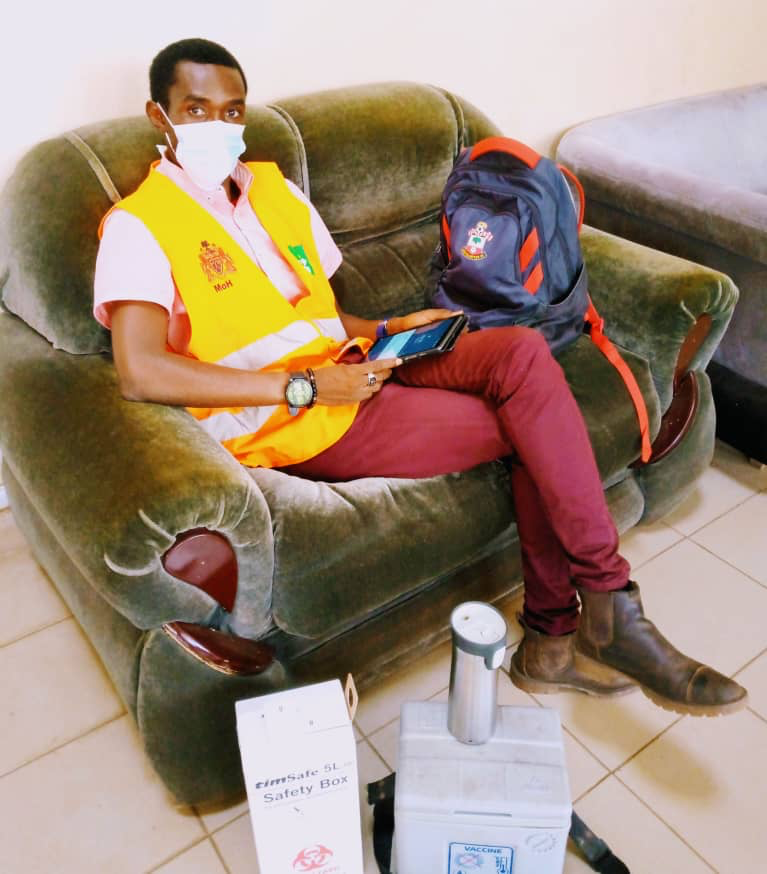Republic of The Gambia lies between 13° and 14° North, and between 13° and 17° West in Western Africa and is the smallest country on the mainland African continent. The country’s borders follow the meanders of the River Gambia, and is less than 50 kilometers (31 miles) wide at its widest point bordered by Senegal on all except for its western coast on the Atlantic Ocean
[1]. As estimated by UN data, the country has a population of about 2,416,668 people as at mid-year 2020
[2]. The present economic, environmental and health risks in the country has translated into high levels of food and nutrition insecurity has left only about 18% of Gambian households food secured
[3]. This has increased poverty rate to 48% and the country now ranks 174 out of 189 countries on the 2019 Human Development Index. Likewise, the pandemic crippled the economic status of the country as the country is heavily dependent on tourism, agriculture and foreign-aid.
With over 64, 000, 000 COVID-19 cases in the world today, The Gambia recorded its first COVID-19 case on March 17, 2020 involving a female Gambian returnee from the United Kingdom and now has over 3000 confirmed cases. The number of cases and the rate of infection did increase, albeit at a slow rate, until mid-July
[4]. This led the Gambian government to take some measures in order to curb the spread of the virus. However, based on HURIDAC’S Human Rights Perspective of COVID-19 report published in May, 2020, the success or failure of a government in the management of the pandemic depends of the state and quality of the healthcare system, the effective and efficient response from the government and all concerned institution and how the citizens responds to the guidelines.
This fact sheet analyzes these and takes into consideration accountability, participation and non-discriminatory approach as the right-based approach in the management of COVID-19 puts Human rights and people at the centre of the management strategy.
As enshrined in Article 22 of the African Charter on Human and Peoples’ Rights, “All peoples shall have the right to their economic, social and cultural development with due regard to their freedom and identity and in the equal enjoyment of the common heritage of mankind.” Hence, the Gambian government is expected to afford her citizens the rights to life and good healthcare. This report which is driven by the COVID-19 data analysis of the country shows how the Gambian government has managed the pandemic in respect to human rights.
SUCCESS INDICATORS
Based on HURIDAC’S Human Rights Perspective of COVID-19 report, the three success indicators identified are used to analyze the effect of the pandemic on the right of the people.
Effective Management
On March 27 2020, a state of public health emergency was declared by the president which involved closing of all non-essential public and private businesses, airspace and land borders. This also included enforcement of social distancing, regulation of number of passengers carried by commercial vehicles and restrictions on the number of persons at funerals and all public gatherings. Prices of essential commodities such as rice, meat, fish, cooking oil, soap, sanitizers, and cement were capped by the government to cut down inflation and also restrict movement
[5]. Another 21 days’ public emergency regulation was announced by the president which took effect from August 6, 2020 due to the spike in the number of reported cases around mid-July. The regulation imposed a night-time curfew between the hours of 10 p.m. and 5 a.m. and re-introduced a ban on all public gatherings. All non-essential businesses, educational institutions, and places of worship were closed. This regulation was extended on 27th August but restrictions on opening of worship centres and schools for Grade 9 and 12 students were eased. Palliatives were also given to households and media houses.
The Ministry of Health and other relevant institutions were reallocated 0.6 percent of GDP from the current budget to boost containment measures in-order to prevent and control the spread of the COVID-19 outbreak. A student relief fund was initiated to support Gambian students and a nation-wide food distribution program which benefitted about 84 percent of the households was also launched
[6]. In addition, 2,000 tons of fertilizer were distributed to support the needs of farmers. These actions benefitted from technical support from the country’s development partners, including WFP and FAO. Also, fuel prices were reduced to prevent transport price hikes and help ease the burden on commercial transport operators.
Quality of Public Health Systems
The population growth rate and infant mortality rate in The Gambia are among the highest in western Africa
[7]. Life expectancy in The Gambia is 62 years which is comparable to the regional average but lower than that of the world. The ratio of physicians to patients is 0.11 physicians per 10,000 population and 11 hospital beds per 10,000 population
[8].The healthcare system in The Gambia is built around 3 levels of systems. The primary level is focused on villages with a population of over 400 individuals while in the secondary level medical care is provided by the large and small health centres. In the tertiary level health services are delivered by the four main referral hospitals, the Medical Research Council (MRC), several private clinics and NGO-operated clinics
.[9]The Gambia’s health sector has over the years been under great pressure due to a number of factors: the high population growth rate, inadequate financial and logistic support, shortage of adequately and appropriately trained health staff and lack of efficient and effective referral system
[10].Frontline health workers were categorized into four based on their risks, which are low risk, moderate risk, high risks and high risk plus. Allowances were paid to them after an initial protest based on the category each fell into
[11]. Inadequate PPE’s and medical staff was attributed to have also been a factor that increased the number of cases in the country. The country is highly understaffed as regards to medical practitioners having a little over 200 medical doctors in the country
[12].Citizens Compliance
The pandemic devastated the livelihoods of a large proportion of the population, especially the street vendors and market men and women by disrupting their ability to do their jobs and leaving many in a fight for survival. Although it took a while for full citizens’ compliance, a decline in the number of daily reported cases was seen in September. Over 90% of the citizens complied with the guideline after the spike in daily recorded cases in mid-July. This was attributed to the increase in sensitization programs that enhanced citizens participation hence the people started obeying the guidelines set by the public health authorities, especially wearing of masks and social distancing as people realized that all that the health authorities and WHO had been saying were true
[13].Goal of the Analysis
The goal of this analysis is to highlight the human rights perspective of the government in the management of the pandemic and the prioritizing of citizen’s rights to life and affordable healthcare.
Situation Overview
- Confirmed Cases
Number of positive confirmed cases increased from 4 in March to 3726 as at the end of November, 2020. Number of deaths also increased to 123 at the reporting period. The survival ratio decreased to 35:1, despite the spike recorded in mid-July with survival ratio of 65:1. Figure 1.a: Number of Confirmed Cases in Percentage from 17th March till November, 2020
Figure 1.b: Number of Confirmed Cases in Figures from 17th March till November, 2020
Figure 1.c: Number of Confirmed Cases Per Month from 17th March till November, 2020
The number of reported cases per month as shown in the graph above shows that there was a gradual increase in the number of monthly reported cases from March to June and a sporadic increase in mid-July till late September and a gradual decease in October and November.
- Confirmed Deaths
Figure 2: Number of confirmed deaths from 17th March to November, 2020
The number of deaths recorded at the beginning of the pandemic in the country was low in the early months but a gradual increase was recorded up until November, 2020.
- Confirmed Deaths and Recovery
Figure 3: Number of confirmed deaths versus recovery from 17th March to November, 2020
The recovery rate shows the rate of recovery of the citizens from the virus (Coronavirus). Following the parlance of human rights, the government should ensure that all measures are put in place to achieve a high rate of recovery. In sequel to this, the data shows an increase in the rate of recovery to having 3,601 recovered from the virus as at November, 2020.
- Survival Ratio
Figure 4: Survival Ratio of cases per month from 9th of March till 30th September, 2020.
The survival ratio reveals the difference between the confirmed cases and deaths. It shows the chances of survival from the virus (Coronavirus) within the country’s data set. This excludes underlying health conditions. The survival rate decreased as the month progressed up till July and increased in August up till November.
- Covid-19 The Gambia’s Dashboard:
- Covid-19 The Gambia’s Animation Video
- Recommendations
- There is an urgent need for the government to strengthen the health system of the country by training and employing more medical personnel, increase the number of medical centres, proper management of isolation centres and provide adequate number of PPE’s to all arms for proper work discharge and control on the spread of the virus.
- The government should structure and further facilitate access to health facilities for the people, especially the most vulnerable (women and children inclusive) and those at greatest risk.
- Restrictions and regulations on guidelines should be strictly enforced and not loosened or disobeyed by every citizens including high-level government officials, as the Epidemiology and Disease Control Unit of the Ministry of Health blamed the loosening of restrictions including airspace and land borders with Senegal as the cause of the spike in the number of cases in Mid- July.
- There is a need for more enlightenment and sensitization programs especially in the rural areas as some citizens are still in denial of the presence and fatality of the virus. Priority should be given to market women in this initiative as a large number of households in the country have at least one.
- Enforcement officers should be trained on implementation of the regulations, especially to avoid torture and harassment of citizens. The rights of the people should be prioritized at all cost.
Facts
0.17% of cases in Africa
1.81% of cases in West Africa
0.24% of Deaths in Africa
4.29% of Deaths in West Africa
Sporadic spike in Mid-July and August
Over 22times increases in number of cases at the end of July
Over 400% increase in the number of cases at the end of August
[1] https://en.wikipedia.org/wiki/The_Gambia
[2] data.un.org/en/iso/gm.html
[3] https://www.unicef.org/gambia/media/566/file/The-Gambia-National-Nutrition-Survey-2015.pdf
[4] https://www.imf.org
[5] https://www.thegambiatimes.com/the-economic-implications-of-covid-19-on-the-gambia
[6] https://www.imf.org
[7] https://www.britannica.com/place/The-Gambia
[8] https://www.who.int/goe/publications/atlas/2015/gmb.pdf?ua=1
[9] https://www.accessgambia.com/information/health-care
[10] https://www.who.int/workforcealliance/members_partners/member_list/dpehgambia/en/
[11] https://allafrica.com/stories/202007140258.html
[12] https://www.aa.com.tr/en/africa/gambia-s-health-system-near-collapse-amid-pandemic/1937191
[13] https://www.chronicle.gm/gambia-drop-in-covid-19-cases-public-compliance-pay-dividends


